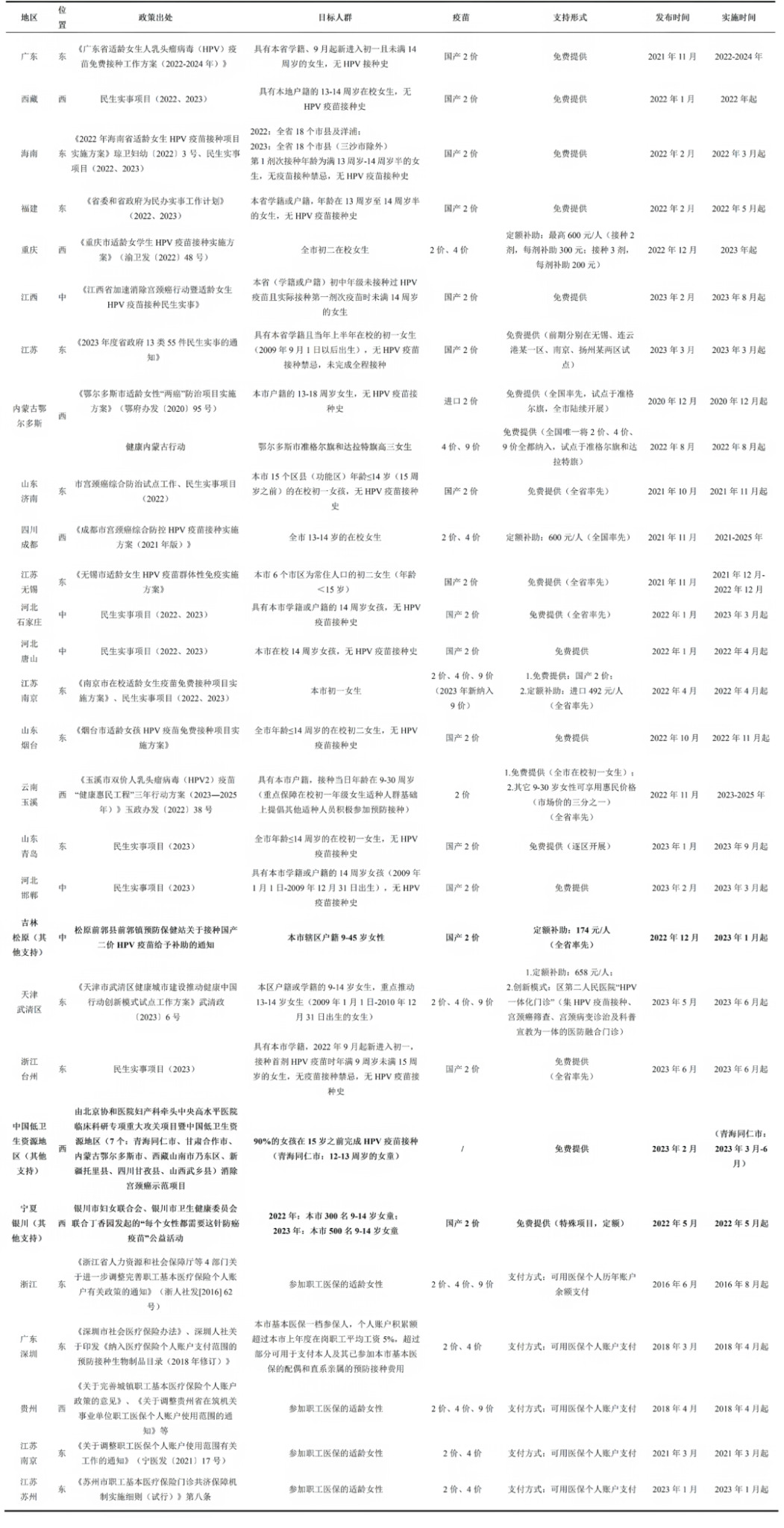The epidemiology of HPV infection in China has both similarities and differences compared to the global data. Table 1 compiles the prevalence of HPV infection in China as summarized by different systematic reviews and meta-analysis studies. Published systematic reviews and multicenter studies have shown that the total corrected HPV infection rate in the general population ranges from about 13.1-18.8%, with a corrected infection rate of 12.95-17.1% for high-risk HPV and 3.28% for low-risk HPV [1, 2, 3].
The prevalence of HPV infection varies according to the region and the population group, with a range of about 14.9%-16.0% in urban areas and about 13.7%-16.3% in rural areas [4, 5]. The highest infection rates of total HPV, high-risk and low-risk types among women population (based on the regular physical check data) were in East China, with 17.54%, 14.17% and 3.75%, respectively. The total HPV infection rate, high-risk and low-risk HPV type infection rates were higher in South China than in the North [5]. HPV infection rates also vary by age groups. A multicenter cross-sectional survey study indicated that the rate of high-risk HPV infection in China showed a double-peak in puberty and perimenopause. The urban and rural HPV infection rates all change with age. Higher infection rates were observed in those younger than 25 and those between the ages of 41-45. The second peak of infection may be related to the increase in exposure to HPV, and the changes in the internal environment of the female organism and the immune system [2, 6].
Table 1. Systematic reviews and meta-analysis studies related to HPV infection rate in China
| First author (year of publication) | Research methodology | Key findings |
| General Population or Population with Routine Physical Check | ||
| Zhu et al. (2019)[3] | Systematic review and data review, incorporating data from 71 different sources of databases and literature published by October 2018 | The national prevalence of HPV infection was about 15.54% (95% CI: 13.83%-17.24%), 14.86% (95% CI: 12.84%-16.88%) in the urban areas and 13.70% (95% CI: 11.18%-16.22%) in the rural areas. Among them, 19.85% (3.46%-36.23%) were in the Northeast, 18.43% (95% CI: 13.39%-23.46%) in the North, 12.96% (95% CI: 8.44%-17.48%) in the Central, 13.51% (11.34%-15.68%) in the South, 12.92% (95% CI: 5.31%-20.48%) in the Southwest, 12.57% (95% CI: 8.49%-16.65%) in the Northwest, and 15.99% (95% CI: 12.84%-19.13%) in the East. |
| Yu et al. (2020) [5] | Studies on HPV infection and type distribution among the Chinese female population with routine physical checks between 1995 and 2016 were reviewed, and 19 papers were included. | The prevalence of HPV infection among the population with routine physical checks in Mainland China was 16.18% (95% CI: 14.16-18.20%). The prevalence of high-risk types was 12.95%, and that of low-risk types was 3.28%. The most common types of HPV were HPV 16, 52, 58, 33, 18, and 68. The highest total HPV prevalence among the population with routine physical checks was in Central China (17.54%), and the highest prevalence of high-risk and low-risk types was in East China (14.17% and 3.75%, respectively). The total infection and high-risk and low-risk infection rates were higher in the south than in the north. |
| People with cervical cancer lesions | ||
| Wei et al. (2020) [7] | Studies on HPV infection and type distribution in the Chinese female population between January 1990 and October 2018 were reviewed, and a total of 63 papers were included. | The total HPV infection rate gradually increased with the severity of lesion grade, and was 67.2%, 79.1%, 85.9% and 85.3% in the cervical intraepithelial neoplasia grade 1 (CIN1), cervical intraepithelial neoplasia grade 2 (CIN2), cervical intraepithelial neoplasia grade 3 (CIN3) and cervical cancer populations, respectively. The distribution of HPV types varied among different grades of cervical lesions, with HPV16/18/58 being the top three most common types in cervical cancer, HPV16/58/52 in both CIN3 and CIN2, and HPV16/52/58 in CIN1. HPV52 was the second most common type in CIN1, but its proportion began to decline in CIN2, CIN3 and cervical cancer. The prevalence and type distribution of HPV infection varied in different regions, with high-risk HPV infection being the most common type of infection in each region. |
| Zhang et al. (2020) [8] | Meta-analysis including 8 studies published from 2000-2019 | In 2950 CIN1 and 5393 CIN2/3 patients, the prevalence of HPV infection was 84.37%. The prevalence of CIN1 patients was 79.56% and the most common genotypes were HPV52, 16, 58, 18, 53. The prevalence of HPV infection in CIN2/3 patients was higher at 87% and the most common genotypes were HPV16, 58, 52, 33, 31. |
HPV: human papillomavirus CIN: cervical intraepithelial neoplasia, CI: confidence interval
HPV16, 52, 58, 33, 18, and 68 are the common HPV genotypes in China, of which the prevalence of HPV types are HPV16 (2.66%-3.52%), HPV52 (2.20-2.66%), HPV58 (1.94%-2.10%), HPV18 (0.87%-1.20%), and HPV33 ( 0.87%-1.02%) [1, 2]. In China, low-risk types are mainly HPV6, 11 and 42. Among them, HPV types vary in different regions. Table 2 lists the common HPV types in healthy populations in seven regions of China.
Table 2. Common HPV types in different regions of China
| Region | Common HPV types |
| North | HPV-16 /6 /56 /66 /33 /11 |
| Northwest | HPV-16 /52 /58 /33 /18 /31 |
| East | HPV-16 /52 /58 /18 /33 /68 |
| South | HPV-52 /16 /58 /51 /56 /18 |
| Central | HPV-52 /58 /16 /66 /33 /68 |
| Southwest | HPV-52 /58 /16 /68 /56 /66 |
| Northwest | HPV-16 /58 /35 /18 /6 /39 |
(Source: Yu Yanqin et al. (2019). A systematic review of human papillomavirus prevalence and distribution of HPV genotypes covered by the nine-valent vaccine among women undergoing routine physical checks in mainland China. Tumor Prevention and Treatment, 32(2), 103-113. )
Studies in China have also found that in patients with different grades of cervical lesions and different degrees of cervical cancer, the prevalence of HPV infection gradually increases with the severity of lesion grade [7, 8]. A multicenter population-based cross-sectional study found that the prevalence of infection was 37.1% in women with atypical squamous epithelial cell alterations (ASCUS), 90.9% in women with low-grade squamous intraepithelial lesions (LSIL), and 93.06% in women with high-grade squamous intraepithelial lesions (HSIL) [9]. In those with varying degrees of cervical lesions, the prevalence of HPV infection increased with the degree of the lesion, common types being HPV16 (59.5%), HPV18 (9.6%), HPV58 (8.2%), HPV52 (6.5%), and HVP33 (3.5%) [1, 7].
Another systematic review found that the common HPV types among women with CIN1 were HPV52 (20.31%), HPV16 (16.81%), HPV58 (14.44%), HPV18 (6.44%), and HPV53 (5.76%), whereas the common HPV types among women with CIN2/3 were HPV16 (45.69%), HPV58 (15.50%), HPV52 (11.74%), HPV33 (9.35%) and HPV31 (4.34% ) [8,10]. Table 3 summarizes the major HPV types in patients with different grades of cervical lesions and cervical cancer in different regions of China.
Table 3. The most common HPV types in patients with cervical cancer of different regions and levels in China
| Region | Patients with invasive cervical cancer | Cervical intraepithelial Neoplasia grade 3 | Cervical intraepithelial Neoplasia grade 2 | Cervical intraepithelial Neoplasia grade 1 |
| East | HPV16/18/58 | HPV16/58/52 | HPV16/58/52 | HPV16/52/58 |
| South | HPV16/18/58 | HPV16/52/58 | HPV52/16/58 | HPV52/16/58 |
| West | HPV16/18/58 | HPV16/58/33 | HPV16/58/52 | HPV52/16/58 |
| North | HPV16/18/58 | HPV16/58/33 | HPV16/58/52 | HPV16/52/58 |
(Source: WEI Meng-na,YU Yan-qin,XU Hui-fang,etc. Prevalence and genotypes distribution of human papillomavirus in patients with different grades of cervical lesions in mainland China. Chinese Journal of Clinical Oncology and Rehabilitation,2020,02:133-137)
Content Reviewer: Kelly Hunter, Zhangyang Pan
Page Editor: Jiaqi Zu
References:
- Wang HQ, Zhao FH, Zhao Y. Expert consensus on immunological prevention of human papillomavirus-related diseases. Chinese Journal of Preventive Medicine. 2019, 53(8):761-803.
- Zhao FH, Lewkowitz AK, Hu SY, Chen F, Li LY, Zhang QM, Wu RF, Li CQ, Wei LH, Xu AD: Prevalence of human papillomavirus and cervical intraepithelial neoplasia in China: A pooled analysis of 17 population‐based studies. International journal of cancer 2012, 131(12):2929-2938.
- Zhu B, Liu Y, Zuo T, Cui X, Li M, Zhang J, Yu H, Piao H: The prevalence, trends, and geographical distribution of human papillomavirus infection in China: The pooled analysis of 1.7 million women. Cancer medicine 2019, 8(11):5373-5385.
- Shan W, Zhang T, Zhang TJ, Zhao GM. The epidemiological situation of human papillomavirus infection among women in China. Chinese Journal of Disease Control & Prevention 2017, 21(1):89-93.
- Yu Yanqin et al. (2019). A systematic review of human papillomavirus prevalence and distribution of HPV genotypes covered by the nine-valent vaccine among women undergoing routine physical checks in mainland China. Tumor Prevention and Treatment, 32(2), 103-113.
- Zhang SK, Zhao FH, Qiao YL. Development and achievements regarding the prevention and control of cervical cancer in the last 20 years in China. Chinese Journal of Epidemiology 2020, 41(6):809-812.
- Wei MN, Yu YQ, Xu HF, Fu SL, Hu SY, Zhao FH, Qiao YL. Prevalence and genotypes distribution of human papillomavirus in patients with different grades of cervical lesions in China’s Mainland. Chinese Journal of Clinical Oncology and Rehabilitation 2020, 2.
- Zhang J, Cheng K, Wang Z: Prevalence and distribution of human papillomavirus genotypes in cervical intraepithelial neoplasia in China: a meta-analysis. Archives of Gynecology and Obstetrics 2020:1-9.
- Wu E-Q, Liu B, Cui J-F, Chen W, Wang J-B, Lu L, Niyazi M, Zhao C, Ren S-D, Li C-Q: Prevalence of type-specific human papillomavirus and pap results in Chinese women: a multi-center, population-based cross-sectional study. Cancer causes & control 2013, 24(4):795-803.
- Chen W, Molijn A, Enqi W, Zhang X, Jenkins D, Yu X, Quint W, Schmidt JE, Li J, Pirog E: The variable clinicopathological categories and role of human papillomavirus in cervical adenocarcinoma: A hospital-based nationwide multi‐center retrospective study across China. International journal of cancer 2016, 139(12):2687-2697.





